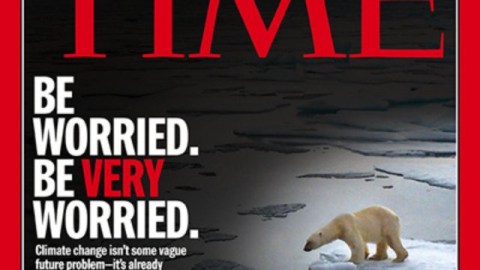Communicating About Climate Risks While Avoiding Dire Messaging

In a guest post today, Melissa Johnson considers the challenge in conveying the risks of climate change without resulting to dire messages that might unintentionally seed ambivalence or even strengthen denial on the issue. Johnson is a graduate student in this semester’s course on “Science, the Environment and the Media” at American University – MCN.
The predicted effects of climate change are a frightening prospect – effects so extraordinary that they have the ability to displace millions through sea level rise and increase the probability of severe weather, drought, flooding, and infectious disease. Despite the scientific likelihood that these events are already occurring, and regardless of the emphasis environmental organizations and even the media place on communicating these risks, polls still show that the American public regards climate change as a low national priority or not a priority at all. If efforts at communicating about these likely risks are not resulting in the expected impact on the public, how can risk communication be better applied, or should appeals to severe risks be applied at all?
Understanding Risk Perceptions
Anthony Leiserowitz argues that risk perception is shaped by emotion and affect as opposed to cognitive understanding. Saffron O’Neill and Sofie Nicholson-Cole further define the concept employed as fear appeal, in which an individual acknowledges the existence of a threat, feels a subsequent emotion of fear or uneasiness, and evaluates the perceived response efficacy. Fear appeal as a communications strategy, they argue, is “designed to arose fear in order to promote precautionary motivation and self-protective action.” Mike Hulme argues that one of the primary reasons there are disagreements over climate change is that everyone evaluates risks differently.
While many political issues such as national security, public health, and economics are heavily influenced by individual and collective fear, climate change may be unique from these other threats due to its “creeping,” incremental nature. In a survey conducted by Leiserowitz, a strong majority of Americans (68%) were most concerned with the impacts on the globe as a whole and on nonhuman nature. Only 22% showed concern for the impacts on the United States, their communities, and their families. These results clearly demonstrate that the majority of Americans feel a spatial distance with the effects of climate change. Perceived as remote from day-to-day living, climate change is often rated by individuals as secondary to other more pressing concerns.
Perceptions and Fear Appeals
O’Neill and Cole argue that a perceived temporal separation from the risks of climate change also affects the long-lasting impacts that fear appeals make. A study conducted by Thomas Lowe, et al, on the impact the movie The Day After Tomorrow had on filmgoers’ perception of climate change supports this theory. It was found that although respondents had experienced a heightened sense of concern immediately after seeing the movie, the sense of urgency to act diminished within the four weeks following. According to O’Neill and Cole, research shows that individuals have difficulty visualizing 15 to 20 years in the future, further supporting the conception that it is not an immediate and relevant concern to most individuals.
Uncertainty also plays a major role in the public’s perception of perceived risks of climate change. While the fact that climate change is occurring as a result of man-made influences is undisputed among scientists and is generally accepted by the public, uncertainty remains over the potential consequences and the solutions needed to mitigate and adapt. From this uncertainty arises a question on what can and should be done. Dr. Sol Hart, a professor of communication at American University, suggested that the Extended Parallel Process Model (EPPM) provides a useful approach to how individuals respond to potential threats. The EPPM posits that individuals will respond to a threat by either engaging in danger control, in which action is taken to reduce the threat, or fear control, in which the actual threat is not addressed and individuals instead avoid, or become skeptical of the issue. The response that an individual takes is guided by whether or not they feel that there is an effective action they can engage that might address the threat – when individuals do not perceive that they have efficacy to address the threat they are more likely to engage in fear control. This type of response is especially likely for risks that are complex, require multiple stakeholders for action, and have no clear path forward on action that can be taken.
Given the gravity of the problem, it would be impossible to portray climate change in a solely rosy light. The risks are an essential part of the discussion and to downplay these would be misguided and counterproductive. It is important, however, to ensure that the dialogue with the public is relevant and relatable by connecting the potential risks to their immediate lives. More importantly, it is also essential that the dialogue include manageable solutions that the public does not necessarily feel compelled to take part in but where positive benefits will be seen, such as the advancement of renewable energy sources that make the air and water cleaner, herald technological advancement and employment, and have the added benefit of reducing our emissions.
–Guest post by Melissa Johnson, a MA student in theGlobal Environmental Politics Program in the School of International Service at American University.This post is part of the course “Science, Environment, and the Media” taught byProfessor Matthew Nisbetin theSchool of Communication at American. See alsoother postson the climate change debate by Ms. Johnson and members of her project team.





